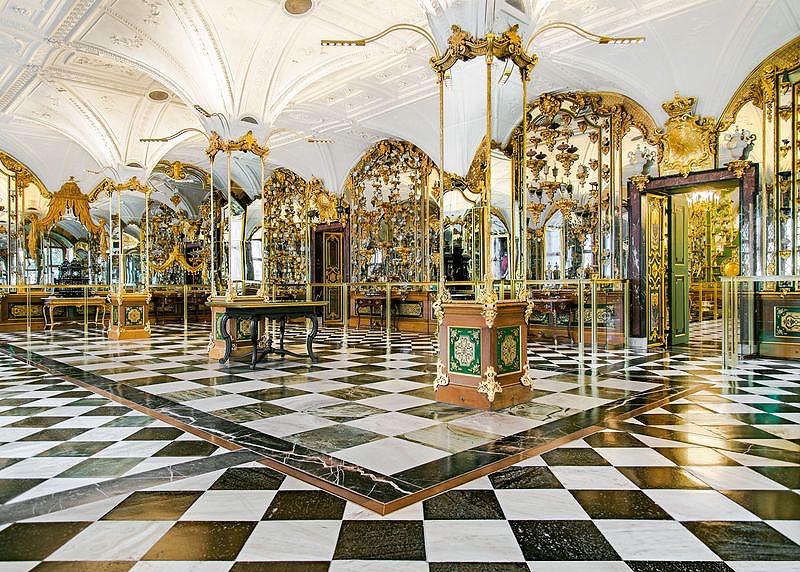As we wrote on this blog last year, in connection to our performances of Bach's Cantata 198, the originally Protestant Elector of Saxony, August II the Strong, converted to Catholicism in order to become King of Poland.
In 1708 he founded the first Catholic church in Dresden, using a former opera house. In 1712, his son, then age 16, also converted to Catholicism, and in 1719 married Maria Josepha of Austria, thus forming a strong alliance with the Habsburg dynasty.
Maria Josepha of Austria, Crown Princess at the Dresden court at the time Zelenka wrote his Missa Divi Xaverii.
Maria Josepha was a devout Catholic and played an important role in the building of a proper Catholic court church in Dresden. The Crown Prince and Crown Princess wouldn't officially become King and Queen until 1733, but would have been the practical rulers of the Dresden court, as August II the Strong was often at his court in Poland. Maria Josepha attended Mass at least twice a day, eventually even four times a day. Her arrival at court in 1719 meant that more music was required for Catholic church services.
Shortly after Maria Josepha arrived at court, in 1720, a scandal caused the temporary dismantling of the court opera until 1730. In those 10 years, musical life at the Dresden court became focused on church music, and it was mostly Jan Dismas Zelenka (1679-1745) who composed it.
Maria Josepha’s devotion to Saint Xavier was widely known. At the end of the year 1729, the Superior of the Dresden Jesuits wrote in his annual report to Rome that the celebration of Saint Xavier’s Saint’s Day had been something quite special that year, and in this report he calls the Princess “Serenissima Nostra Xaveriophila”
It was on that Saint’s Day, December 3, 1729, that Zelenka’s Missa Divi Xaverii, on our program this week, was first performed. To learn more about this Mass, read Patricia Jennerjohn’s program notes on this blog here.
Jan Dismas Zelenka, a well-rounded musician from Bohemia, had trained in Prague, and started working at the court of August II the Strong in 1710 as a double bass player in the orchestra. In 1711 he composed his first Mass. The work must have impressed the court, because his salary was increased to 350 thalers. This placed him among the most highly paid musicians in the Hofkapelle. Three years later, it was raised to 400 thalers. In 1715, he was approved for a travel stipend to accompany the Crown Prince to Venice, but instead opted to go study composition with Fux in Vienna.
In 1723, coincidentally the same year that Bach wrote his first version of the Magnificat, Zelenka wrote an extensive set of Responsories for Holy Week, a work that was venerated by Johann Georg Pisendel (1688-1755), a fellow composer, bosom friend, and the principal violinist at the Dresden court. In 1749, four years after Zelenka's death, Pisendel sent Telemann a copy he had made of parts of the Responsoria, with the following letter:
"At last I have the pleasure of offering you Responsoria by the blessed Mr. Zelenka, with the sincere wish, brother, that you might be granted the delight of tasting the sweet fruits of this almond tree."**
Zelenka wrote over 20 masses, four extensive oratorios and requiems, two Magnificats and Te Deum settings, 13 litanies, many psalms, hymns, and antiphons. The Missa Divi Xaverii we perform this week is one of his most lavishly scored, for choir, vocal soloists, strings, two flutes, two oboes, bassoon, four trumpets, and timpani.
He also wrote a large number of instrumental works: trio sonatas, overtures, symphonies, and concertos.
Johann Georg Pisendel, concertmaster at the Dresden Hofkapelle and bosom friend of Zelenka
According to J.S. Bach's biographer J.N. Forkel, Bach knew Zelenka personally and held the composer in great esteem. Since we have no personal letters by Bach, we don't know how they met, but it most probably happened through Pisendel. Pisendel had been friends with Bach since 1709 and several scholars think that it was for this Italian-trained virtuoso that Bach wrote his most complicated violin music. It is assumed Bach had Pisendel in mind when writing the violin part of the "Laudamus te" of his Mass in B Minor.
Bach visited Dresden several times, and on each occasion the aristocracy there were made aware of his visit, and te press would write about his public performances. August II the Strong and his entourage also visited Leipzig a few times, and musicians from the Dresden court might have been "guest artists" in some of Bach's cantata performances in Leipzig. ***
It is likely that Bach would have met with Pisendel and others from the famous court orchestra on these visits.
-Wieneke Gorter
** In 1756, one year after Pisendel's death, Telemann tried to gain access to Zelenka's original manuscript of the Responsoria, but was told it was locked away as an "important court possession." At that time it was in a special cabinet in Maria Josepha's rooms in the palace in Dresden. After 1765, Zelenka's manuscripts were hidden away in the Cathedral. Since Zelenka didn't have any heirs, no other efforts were undertaken until Smetana's discovery of Zelenka's music in the 1860s. It is also said that because in largely Lutheran Germany, there was no use for a large collection of Catholic church music, and thus there was no interest in Zelenka's music until the Catholic Czech musicians rediscovered it.
*** Research by Dutch harpsichordist and musicologist Pieter Dirksen shows that it is highly probable that guests from Dresden were visiting Leipzig from at least January 30 to February 2, 1724, and that Bach wrote the violin part of the tenor aria in Cantata 83 (performed on February 2, 1724) specifically for Pisendel.



